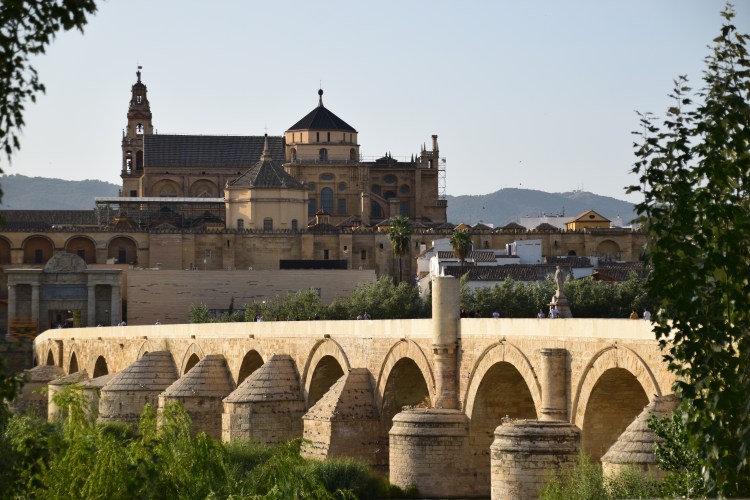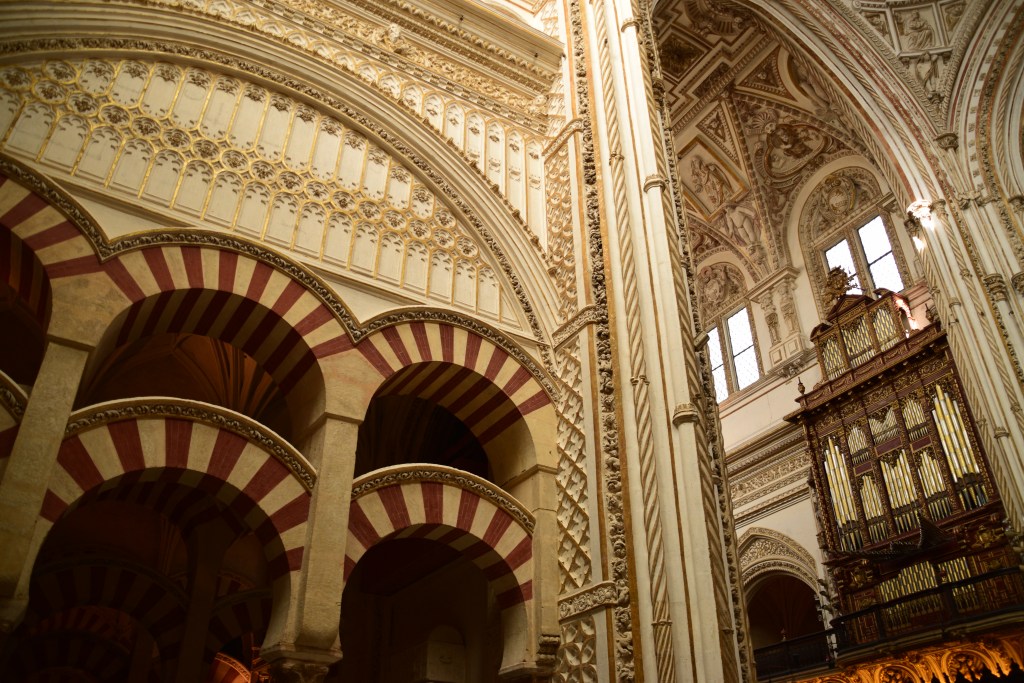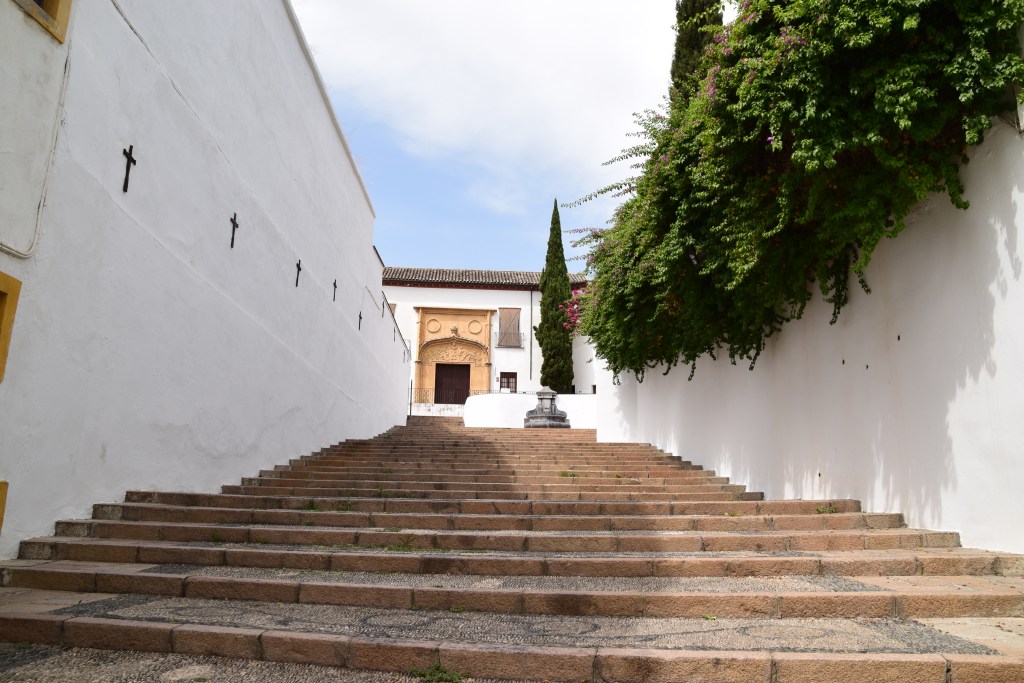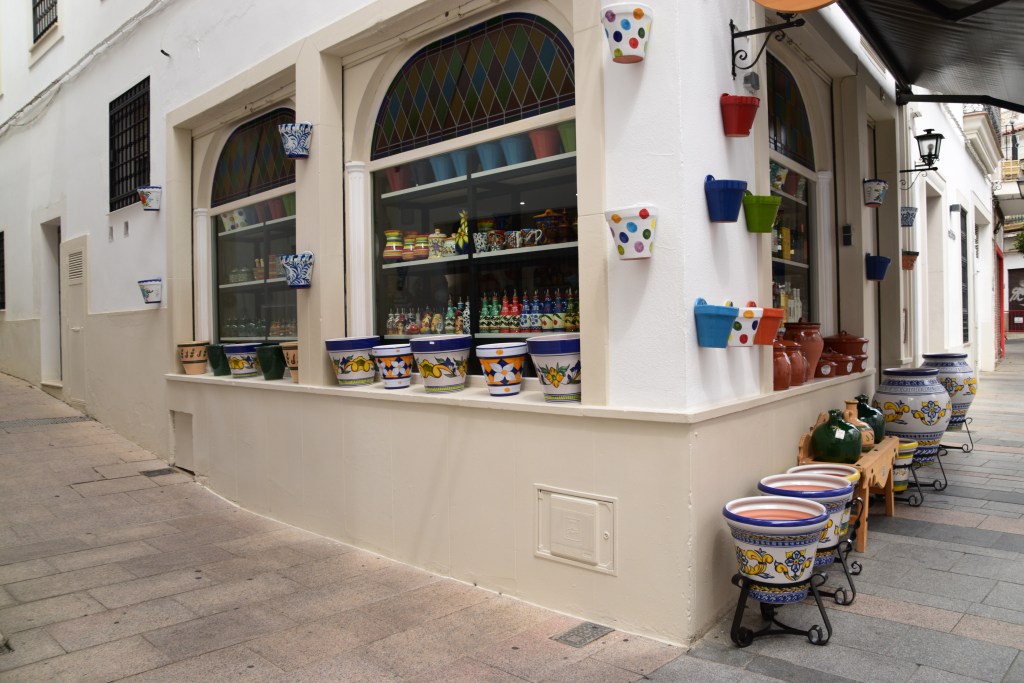I should really change the heading to What you don’t want to miss IS Cordoba because I suspect that for many, if not most visitors to Spain, Cordoba is WAY down the list. That’s OK – I can’t talk – I just recently made it there myself and I reckon it was my 11th visit to Spain, but this city, usually playing second fiddle to the big name destinations, is certainly worthy of inclusion in your next Spanish itinerary.
Did you know that Cordoba boasts four UNESCO World Heritage Sites – more than any other city (yes – including Paris and Rome!!). This was once the most important city in Europe and now there’s plenty of history to absorb, hidden alleys to discover and great food to enjoy. There will be visitors about – but not the hoards of nearby Seville or the masses of Barcelona.
I think you will be …. charmed!
1.La Mezquita
Cordoba reached its greatest glory as the capital of the Moorish kingdom of El-Andalus. And the city’s gem was La Mezquita- the largest mosque of its time in the world. The city was reclaimed by Christians in 1236 and in the 16th century a cathedral was incredibly constructed within the Moorish structure. Nowadays, it is the forest of columns and candy cane arches that brings most visitors to Cordoba.
I’ve written about La Mezquita separately – check it out HERE….
2.Alcázar
Alcázar de Los Reyes Cristianos – Palace of the Christian Kings – was built in the 1300s as a fortress and later served as a residence for Queen Isabella and King Ferdinand. Today, it’s one of Cordoba’s UNESCO World Heritage Sites.
Inside the castle, just its structure remains. However, the main hall – the Hall of Mosaics – houses some spectacular 4th-century Roman frescoes, discovered in the 1950s.
The magnificent gardens are the main attraction here. Surrounded by the four towers of the Alcázar, paths lined with cypress, palm and citrus lead to ornamental pools, fountains, statues and topiary – it’s easy to forget you’re actually in the middle of a city!
3.La Juderia
The proximity of the old Jewish Quarter to the Mosque shows how influential the Jewish community was in Moorish Spain. Having allied themselves with the Arab invaders, many held well-respected posts and occupations. This religious tolerance came to an end under the rule of Queen Isabella and King Ferdinand and the Jews were expelled from Spain in the late 15th century.
Today, the Jewish Quarter retains its maze of narrow cobblestoned streets and white-washed houses. The Synagogue is the only remaining one in Andalusia – now a museum offering guided tours. The entire neighborhood is a UNESCO World Heritage Site.
4.The Patios of Cordoba
Cordoba is one of the hottest cities in Europe in summer (temperatures frequently exceed 40°C !). As far back as Roman times, houses were built around an inner courtyard. This open air space, with its thick stone walls, offered residents a cool retreat. Traditionally filled with plants, flowers, art, tiles, ornate balconies and water features, today’s owners are very proud of their beautiful patios.
While some patios appear to be accessible all year round (we visited late August), May is THE month to visit Cordoba! The two-week Feria de los Patios, sponsored by Córdoba’s town hall, sees more than 50 private owners, as well as convents and other religious buildings, open their courtyards to the public.
This is the time of year when the patios are in full bloom and at their prettiest – bedecked with geraniums, carnations, jasmine and citrus blossoms -and the owners vie for the prestigious prize of most beautiful patio.
5.Puente Romano
The Roman Bridge spanning the Guadalquivir River dates back to the first century BC and was extensively rebuilt in the 10th century during Moorish occupation. At almost 250 meters long and with 16 arches, it was the city’s only bridge until the mid 20th century. Today it’s one of the most beautiful tourist attractions in Cordoba.
Guarding one end of the bridge, the 12th century Torre de la Calahorra once functioned as part of the city’s medieval fortifications.
The tower now houses the Museo Vivo de Al-Andalus which explores the religious and cultural elements that have formed the Andalusian identity and offers insights into the era when the city’s Christian, Jewish, and Muslim communities coexisted in harmony.
In the late afternoon, Cordoba comes to life again after siesta and the bridge fills with locals and tourists alike, mingling with ice cream vendors, buskers and artists. The views at dusk and nighttime are particularly spectacular.
Trivia moment – The bridge appears in Game of Thrones, Season 5.
6. The Plazas of Cordoba
Ah – what’s a Spanish city without it’s plazas! You’ll enjoy just wandering and admiring the grandeur of the architecture, or, better still, lingering a while over lunch or a glass of vino.
One of the most renowned plazas in Cordoba is the Plaza del Potro. named after its fountain (potro=colt) which dates back to 1577. The 1435 inn – Posada del Potro – is mentioned in Miguel de Cervantes’ Don Quixote.
Plaza de las Tendillas might be just the best place to cool down on a hot day!

The 17th century Plaza de la Corredera is the largest square in Andalucia. Once a location for bullfights, horse races and executions, it is now ringed by balconied apartments.
7.Food and Drink
Eating out seems to be a way of life for locals so, needless to say, there is a great choice of restaurants, and tapas bars.
If you are just in town for the day, you’ll easily get a 3 course lunch for around €10 -€12
You can expect to pay €1.50 – €3.50 for tapas – depending on location of course….
For dinner you might enjoy sharing a selection of 1/2 Ración dishes……
….. or opt for a full plate

There are a few must-try local specialities….
Salmorejo is a traditional cold soup with a tomato base (but creamier than gazpacho). It’s typically served with bits of Serrano ham and hard-boiled egg on top.

Caliphal Aubergines – deep-fried and drizzled with honey

Oxtail Stew, one of the most popular stews in the area.

The local wines and beers are well worth a try – especially with a view…..

8.Palacio de Vania
This 15th-century palace features its original decor and offers a chance to admire an exceptional assortment of paintings, antique furniture, mosaics, tilework and tapestries.
But the main attraction here is the ‘garden’. The palace boasts 12 exquisite courtyards, each with its own unique style..
Admission to the gardens is €6 – and another €6 for the house (combined ticket€10) On Wednesday afternoons, entrance to the patio area is free of charge .
9.Templo Romano
In the 1950s, when Cordoba’s town hall was being expanded, the remains of what was probably the city’s most important Roman temple were discovered.
Started during the reign of Emperor Claudius in the middle of the 1st century AD, the ruins indicate a temple of significance. Land close to the city wall was cleared and leveled, creating a square terrace. The temple was built on a podium with six columns in front and ten on each side. The quality of marble suggests skilled craftsmanship and what must have been a particularly beautiful building.
All that’s left now amidst the apartment and office blocks are its foundation, stairs, altar and 10 columns topped with capitals. Other remains were removed to the Archaeological and Ethnological Museum of Córdoba.


10.Medina Azahara
Located in the Sierra Morena mountains, about 8kms west of Cordoba, Medina Azahara – Madinat al-Zahra – is the city’s newest (and 4th!) UNESCO World Heritage Site.
This huge fortified palace-city was started in 936 by Umayyad Caliph of Córdoba, Abd-ar-Rahman III al-Nasir. Cordoba was the Muslim capital of Europe and this city – named after his favourite wife Azahara- would display the power and strength of his realm. Constructed on 3 levels, it included an opulent palace complex, mosque and terraced gardens.
Additions and alterations continued for decades but, within 70 years, it had been sacked and left to ruin.
The site wasn’t rediscovered until the 20th century and it’s estimated that just 10% has been excavated to date. A museum at the base of the site displays ancient objects and architectural elements that were uncovered at the archaeological site.
You can access the site by public bus from Cordoba or by car. There is a car park at the museum / reception entrance and then a shuttle bus – running every 15-20 minutes – takes visitors up the hill to the actual site.
This is the one that got away!! Having skimped on the small print when planning the trip, I didn’t realise we’d have to access the site via shuttle. We arrived at 10.00am for the ticket office opening but had only an hour in total for the site so couldn’t make it work. We’ll just have to go back!!!


Honourable Mentions!!
That’s the problem with TOP 10 Lists – they’re usually not long enough!!!
Walls
Cordoba would have been fortified of course, with walls being demolished to extend the city limits. Over time, the walls crumbled and were reconstructed in places after the Christian conquest. Today, there are still sections of Roman and Arab fortifications to be seen as well as some of the gates.

Museums
Among the city’s 17 museums are …..
Museo Arqueológico de Cordoba will transport you through the city’s rich cultural history.
Museo de Bellas Artes displays mainly Cordoban work.
Museo Julio Romero de Torres – selection of the paintings and personal items of Julio Romero de Torres – considered one of Spain greatest painters.
Casa Ramón García Romero – Ramón García Romero has revived the ancient technique of decorative leatherwork that was used by 10th-century Umayyad artisans.
Museo Municipal de Arte Taurino for those interested in the history of bullfighting.
Galeria de la Inquisicion presents instruments of torture used in the inquisition.
Just Wander!
Most of all, this is a city for wandering the maze of cobbled streets and losing oneself in the alleyways! Just take off and enjoy the white-washed buildings, shops, quiet squares and window boxes – and don’t forget to peep into those gorgeous courtyards!
Small Stuff
Getting There
Airport – Cordoba doesn’t have its own international airport but is still very easy to access. The nearest airports are Seville, Malaga or Madrid.
Train – it’ll take about 2 hours (fast train) from Madrid or 45 minutes from Seville. The train station is a taxi ride, or a 20 minute walk, from the old city.
Bus – Buses offer a good budget option but run less frequently and will take longer than the train.
Car – It takes about 1 hour 45 minutes to drive from Malaga airport or Seville. If you are staying over then search for a hotel with free parking. Car parks are available outside the historic center and are well-marked.
Getting Around
The main attractions are all within walking distance of one another – no need for public transport or taxis.
Day Trip
Many visitors choose to visit Cordoba as a day trip from Seville because they are well-connected and relatively close to one another. With an early start and a full day, you’ll easily see most of the city’s historic sights. Pre-book the Mezquita and work around that.
Summertime is VERY hot here! If – like us – you visit in August then I’d suggest NOT tackling the city as a day tripper. Explore the city in the mornings, enjoy lunch and then make sure you have a hotel with a pool to go back to for the afternoon. You can head out again after siesta when things start to cool down a bit.
Where we Stayed
We wanted (A) somewhere cheap for 3 nights (B) it had to have a pool and (C) free parking.
We opted for Hotel Oasis which was about a 25 minute walk from the historic centre.
Right beside a main road but it didn’t disturb us at all….

The pool and garden was ideal in the afternoons…
Breakfast wasn’t included in our room rate but we sampled the buffet (€7.50) one morning. Bars and cafes in the area serve coffee and toast etc. and Lidl is very close by.
Would we stay there again? Definitely.
Planning a trip to Spain? Have a look at these…..



















































































You’ve sold me on Cordoba! It looks and sound incredible. I love you picture of the Roman Bridge. Maggie
The bridge is lovely Maggie – especially in the evenings and at night….
Great wrap up on Cordoba! and did you get their leather goods! the best in Spain! Fav Meryan….Cheers
Thank you! Actually didn’t get to do any shopping at all. Bought one garish decoration for my Christmas tree and that was it!!
Yikes!there will always be a next time and you know the store 😉
What a remarkable city, and you present it beautifully as always Marie. As to tourism it seems to have found a nice balance. Clearly it needs the visitor dollar to upkeep its historic structures, but it doesn’t have hordes crawling all over the place day and night. Any historic architecture geek would die happy there.
Thank you Roy. I don’t know if it were Covid / heat / or end of season – probably all three – but it wasn’t very busy so it was a pleasure to get around – at the same time there were enough visitors to give a bit of a buzz… There’s certainly enough to see and do over a few days …..
OK you’ve sold me on Cordoba! Nevertheless when we head to Seville this weekend we’ve decided not to try to fit in a day trip here. Seville has more than enough to keep us occupied for the couple of days we’ll be there so we’ll save Cordoba for a future visit 🙂
You’re right – There’ll be loads to keep you busy!!! Have a wonderful time…. XXXXM
Thank you, I’m sure we will 🙂 I’m quite excited to be flying again!
Ah, Seville! How I envy you going there this weekend. Enjoy my favourite Spanish city.
I’m sure we will – thanks Mari 🙂
What a lovely post – Cordoba really is a special place which has a place in my heart. I thought the patios were really special and loved the pride people took in them 🙂
I’d love to get there for the festival some time – imagine those patios in full bloom … they must be stunning!
Wow I’ve never heard of Cordoba, what a hidden gem! Thanks for sharing 🙂
It’s not very far from Seville Lyssy. Many visitors concentrate on the Andalusia region rather than the whole country and can visit these 2 cities as well as Granada… all stunning….
The old city of Cordoba is truly one of the most charming places I’ve ever visited. The history is fascinating and I loved exploring the different cultures that coexisted there and made the city the alluring place it is today. I did not see Medina Azahara during my visit, so there’s a reason to go back. As if the delicious Spanish food wasn’t a motive enough. Incidentally, tomorrow I will visit the Sarajevo Jewish Museum set in an old synagogue. Sarajevo is a city where so many Sephardi Jews from Andalucia ended up settling down and rebuilding their lives after the Catholic Monarchs expelled them.
You’re right – the cultural history is what really makes it a great place to visit…
You’re in a city that we would love to visit – we’ve been to Croatia twice but haven’t ventured further yet – have a lovely time…..
You really have given us Cordoba in depth here, Marie, and quite brilliantly too. I’ve been there 3 times but missed the Plazas as you saw them, guess I’ve returned to the same old spots and spent too long on them. Like you, I love wandering the streets and peering through wrought-iron gates to the court-yards full of geraniums. Your pictures are so much better than mine, I must try harder in future! Love the bridge. Glad you showed the picture of the salmorejo as it brought back so many happy memories. I fell in love with it on my first trip but I may have OD’d on it on my second!
Now this a place I would love to visit. So much history. We should have seen that area of Spain.
Impossible to fit everything in isn’t it!
Love to return to Europe soon.
It might be another while – the ways things are going!
Yes it is such a terrible time in our world.
It reminds me nicely of my trip to Cordoba, like you I would put the mosque first. I remember the moment of surprise when I entered it, the quiet darkness after the dazzling heat of the outside.
Oh how many times over the years have we bolted for churches, mosques… anything .. to get out of the heat for a while!
We fell for Córdoba in a big way. It was a February when we went, and this meant it was fresh and warm, and fairly tourist free. There was interest and character at every turn, and I’d love to explore it again. I enjoyed this virtual tour with you!
I’d never think of going to Spain in Feb… although we were in Malaga one late Oct and it was lovely. We really liked Cordoba – It was last August and terribly hot but we were so starved of the travel experience that we didn’t mind! It wasn’t very busy due to Covid so no crowds at the main sights. I’d definitely go back….
Spain in February is wonderful. Warm, relatively free of tourists, and not rainy cold old Britain!
Ah… doesn’t that sound blissful! Can’t see me getting anywhere this Feb but maybe by 2023…!!
Fingers crossed!
🤞🤞🤞